Evaluation of Adhesive Joints Using Ultrasonic Rayleigh Waves
Abstract
:1. Introduction
2. Research on Adhesive Joints
2.1. Research Procedure
2.2. Materials and Methods
| • Wave velocity | 3200 m/s, |
| • Wave amplification | 70 dB, |
| • P-Delay | 27.86 µs |
| • Probe center | 12 mm |
| • Power | level |
3. Results Analysis and Discussion
4. Conclusions
Author Contributions
Funding
Institutional Review Board Statement
Informed Consent Statement
Data Availability Statement
Conflicts of Interest
References
- Durczak, K.; Selech, J.; Ekielski, A.; Żelaziński, T.; Waleński, M.; Witaszek, K. Using the Kaplan–Meier Estimator to Assess the Reliability of Agricultural Machinery. Agronomy 2022, 12, 1364. [Google Scholar] [CrossRef]
- Przystupa, K.; Beshley, M.; Hordiichuk-Bublivska, O.; Kyryk, M.; Beshley, H.; Pyrih, J.; Selech, J. Distributed Singular Value Decomposition Method for Fast Data Processing in Recommendation Systems. Energies 2021, 14, 2284. [Google Scholar] [CrossRef]
- Durczak, K.; Selech, J. The Quantification of Operational Reliability of Agricultural Tractors with the Competing Risks Method. Teh. Vjesn. 2022, 29, 628–633. [Google Scholar] [CrossRef]
- Mbithi, F.; Worsley, P.R. Adhesives for medical application—Peel strength testing and evaluation of biophysical skin response. J. Mech. Behav. Biomed. Mater. 2023, 148, 106168. [Google Scholar] [CrossRef]
- Gulcicek, E.; Diler, E.A.; Ertugrul, O. Synergistic effect of surface treatment and adhesive type on bonding performance of thin Al6061 joints for automotive applications. Int. J. Adhes. Adhes. 2024, 130, 103641. [Google Scholar] [CrossRef]
- Karaboga, F.; Golec, F.; Yunus, D.E.; Toros, S.; Oz, Y. Mechanical response of carbon fiber reinforced epoxy composite parts joined with varying bonding techniques for aerospace applications. Compos. Struct. 2024, 331, 117920. [Google Scholar] [CrossRef]
- Adams, R.D. Adhesive Bonding Science, Technology and Application; Woodhead Publishing Limited: Sawston, UK, 2005. [Google Scholar]
- Akhavan-Safar, A.; Ramezani, F.; Delzendehroov, F.; Ayatollahi, M.R.; da Silva, L.F.M. A review on bi-adhesive joints: Benefits and challenges. Int. J. Adhes. Adhes. 2022, 114, 103098. [Google Scholar] [CrossRef]
- Kowalczyk, J.; Matysiak, W.; Sawczuk, W.; Wieczorek, D.; Sędłak, K.; Nowak, M. Quality Tests of Hybrid Joint—Clinching and Adhesive—Case Study. Appl. Sci. 2022, 12, 11782. [Google Scholar] [CrossRef]
- Pereira, A.; Fenollera, M.; Prado, T.; Wieczorowski, M. Effect of Surface Texture on the Structural Adhesive Joining Properties of Aluminum 7075 and TEPEX®. Materials 2022, 15, 887. [Google Scholar] [CrossRef]
- Varga, J.; Brezinová, J.; Brezina, J. Quality Analysis of Bonded Joints in the Renovation of Plastic Automotive Parts. Appl. Sci. 2024, 14, 271. [Google Scholar] [CrossRef]
- Possart, W. Adhesion: Current Research and Applications; Wiley-VCH Verlag GmbH & Co. KGaA: Weinheim, Germany, 2005; ISBN 9783527312634. [Google Scholar]
- Geldermann, J.; Peters, N.H.; Nunge, S.; Rentz, O. Best available techniques in the sector of adhesives application. Int. J. Adhes. Adhes. 2004, 24, 85–91. [Google Scholar] [CrossRef]
- Pravilonis, T.; Sokolovskij, E. Analysis of composite material properties and their possibilities to use them in bus frame construction. Transport 2020, 35, 368–378. [Google Scholar] [CrossRef]
- Trembach, B.; Balenko, O.; Davydov, V.; Brechko, V.; Trembach, I.; Kabatskyi, O. Prediction the Melting Characteristics of Self-Shielded Flux Cored arc Welding (FCAW-S) with Exothermic Addition (CuO-Al). In Proceedings of the IEEE 4th International Conference on Modern Electrical and Energy System (MEES), Kremenchuk, Ukraine, 20–23 October 2022; pp. 1–6. [Google Scholar] [CrossRef]
- Ulbrich, D.; Kańczurzewska, M. Correlation Tests of Ultrasonic Wave and Mechanical Parameters of Spot-Welded Joints. Materials 2022, 15, 1701. [Google Scholar] [CrossRef]
- Cognard, P. Ahesives and Sealants. Basic Concepts and High Tech Bonding. In Handbook of Adhesives and Sealants; Elsevier: Amsterdam, The Netherlands, 2005; Volume 1, ISBN 9780080445540. [Google Scholar]
- ASTM D 2095; Standard Test Method for Tensile Strength of Adhesives by Means of Bar and Rod Specimens. ASTM: West Conshohocken, PA, USA, 2015.
- ASTM D882-02; Standard Test Method for Tensile Properties of Thin Plastic Sheeting. ASTM: West Conshohocken, PA, USA, 2018.
- Naito, K.; Onta, M.; Kogo, Y. The effect of adhesive thickness on tensile and shear strength of polyimide adhesive. Int. J. Adhes. Adhes. 2012, 36, 77–85. [Google Scholar] [CrossRef]
- Rudawska, A.; Stancekova, D.; Brzęczek, J. The visual method in quality assessment of single-lap adhesive joints. Adv. Sci. Technol. 2016, 10, 109–118. [Google Scholar] [CrossRef] [PubMed]
- Dixon, S.; Edwards, C.; Palmer, S.B.; Reed, J. Considerations for the Ultrasonic Inspection of Metal-Adhesive Bonds Using EMATs. J. Nondestruct. Eval. 2000, 19, 95–103. [Google Scholar] [CrossRef]
- Hellera, K.; Jacobsa, L.J.; Qub, J. Characterization of adhesive bond properties using Lamb waves. NDT E Int. 2000, 33, 555–563. [Google Scholar] [CrossRef]
- Ravishankar, S.R.; Murthy, C.R.L. Application of acoustic emission in drilling of composite laminates. NDT E Int. 2000, 33, 429–435. [Google Scholar] [CrossRef]
- Tighe, R.C.; Dulieu-Barton, J.M.; Quinn, S. Identification of kissing defects in adhesive bonds using infrared thermography. Int. J. Adhes. Adhes. 2016, 64, 168–178. [Google Scholar] [CrossRef]
- Jansen, C.; Wietzke, S.; Wang, H.; Koch, M.; Zhao, G. Terahertz spectroscopy on adhesive bonds. Polym. Test. 2011, 30, 150–154. [Google Scholar] [CrossRef]
- Zhang, Z.; Khong, C.J.; Koe, B.; Luo, S.; Huang, S.; Qin, L.; Cipiccia, S.; Batey, D.; Bodey, A.J.; Rau, C.; et al. Multiscale characterization of the 3D network structure of metal carbides in a Ni superalloy by synchrotron X-ray microtomography and ptychography. Scr. Mater. 2021, 193, 71–76. [Google Scholar] [CrossRef]
- Smagulova, D.; Yilmaz, B.; Jasiuniene, E. Ultrasonic Features for Evaluation of Adhesive Joints: A Comparative Study of Interface Defects. Sensors 2024, 24, 176. [Google Scholar] [CrossRef]
- Yilmaz, B.; Asokkumar, A.; Jasiūnienė, E.; Kažys, R.J. Air-Coupled, Contact, and Immersion Ultrasonic Non-Destructive Testing: Comparison for Bonding Quality Evaluation. Appl. Sci. 2020, 10, 6757. [Google Scholar] [CrossRef]
- Bockenheimer, C.; Fata, D.; Possart, W.; Rothenfusser, M.; Netzelmann, U.; Schaefer, H. The method of non-linear ultrasound as a tool for the non-destructive inspection of structural epoxy-metal bonds—A resume. Int. J. Adhes. Adhes. 2002, 22, 227–233. [Google Scholar] [CrossRef]
- Brotherhood, C.J.; Drinkwater, B.W.; Dixon, S. The detectability of kissing bonds in adhesive joints using ultrasonic techniques. Ultrasonics 2003, 41, 521–529. [Google Scholar] [CrossRef] [PubMed]
- Vijaya Kumar, R.L.; Bhat, M.R.; Murthy, C.R.L. Evaluation of kissing bond in composite adhesive lap joints using digital image correlation: Preliminary studies. Int. J. Adhes. Adhes. 2013, 42, 60–68. [Google Scholar] [CrossRef]
- Samaitis, V.; Yilmaz, B.; Jasiuniene, E. Adhesive bond quality classification using machine learning algorithms based on ultrasonic pulse-echo immersion data. J. Sound Vib. 2023, 546, 117457. [Google Scholar] [CrossRef]
- Spytek, J.; Ambrozinski, L.; Pieczonka, L. Evaluation of disbonds in adhesively bonded multilayer plates through local wavenumber estimation. J. Sound Vib. 2022, 520, 116624. [Google Scholar] [CrossRef]
- Liu, T.; Pei, C.; Cheng, X.; Zhou, H.; Xiao, P.; Chen, Z. Adhesive debonding inspection with a small EMAT in resonant mode. NDT E Int. 2018, 98, 110–116. [Google Scholar] [CrossRef]
- Wojtczak, E.; Rucka, M. Damage imaging algorithm for non-destructive inspection of CFRP/steel adhesive joints based on ultrasonic guided wave propagation. Compos. Struct. 2022, 297, 115930. [Google Scholar] [CrossRef]
- Bolstad, P.K.; Frijlink, M.; Hoff, L. Evaluation of bonding techniques for ultrasound transducers. Microelectron. Reliab. 2023, 151, 115272. [Google Scholar] [CrossRef]
- Vervaeke, R.; Debruyne, S.; Vandepitte, D. Numerical and experimental analysis of vibration damping performance of polyurethane adhesive in machine operations. Int. J. Adhes. Adhes. 2019, 90, 47–54. [Google Scholar] [CrossRef]
- Adams, R.D.; Cooper, D.G.A.; Pearson, S. Vibration Damping of Adhesively Bonded Joints. In Handbook of Adhesion Technology; Springer: Berlin/Heidelberg, Germany, 2011; pp. 765–786. [Google Scholar] [CrossRef]
- Santos, M.; Santos, J. Adhesive Single-Lap Joint Evaluation Using Ultrasound Guided Waves. Appl. Sci. 2023, 13, 6523. [Google Scholar] [CrossRef]
- Ren, B.; Lissenden, C.J. Ultrasonic guided wave inspection of adhesive bonds between composite laminates. Int. J. Adhes. Adhes. 2013, 45, 59–68. [Google Scholar] [CrossRef]
- Rose, J.L. Chapter 18—Ultrasonic inspection of adhesive bonds. In Adhesion Science and Engineering; Elsevier: Amsterdam, The Netherlands, 2022; Volume 1, pp. 699–724. [Google Scholar]
- Li, J.; Gopalakrishnan, K.; Piao, G.; Pacha, R.; Walia, P.; Deng, Y.; Chakrapani, S.K. Classification of adhesive bonding between thermoplastic composites using ultrasonic testing aided by machine learning. Int. J. Adhes. Adhes. 2023, 125, 103427. [Google Scholar] [CrossRef]


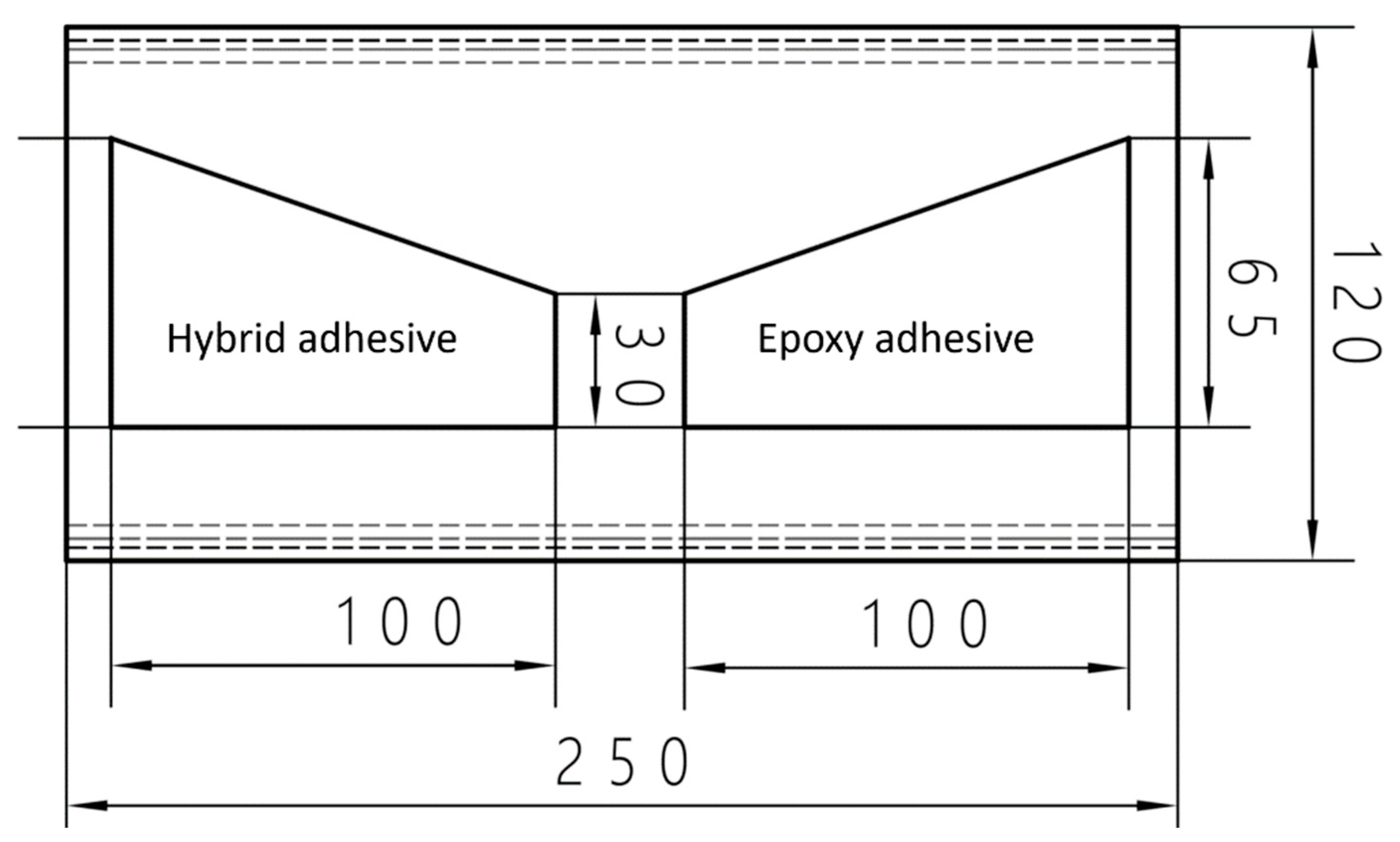
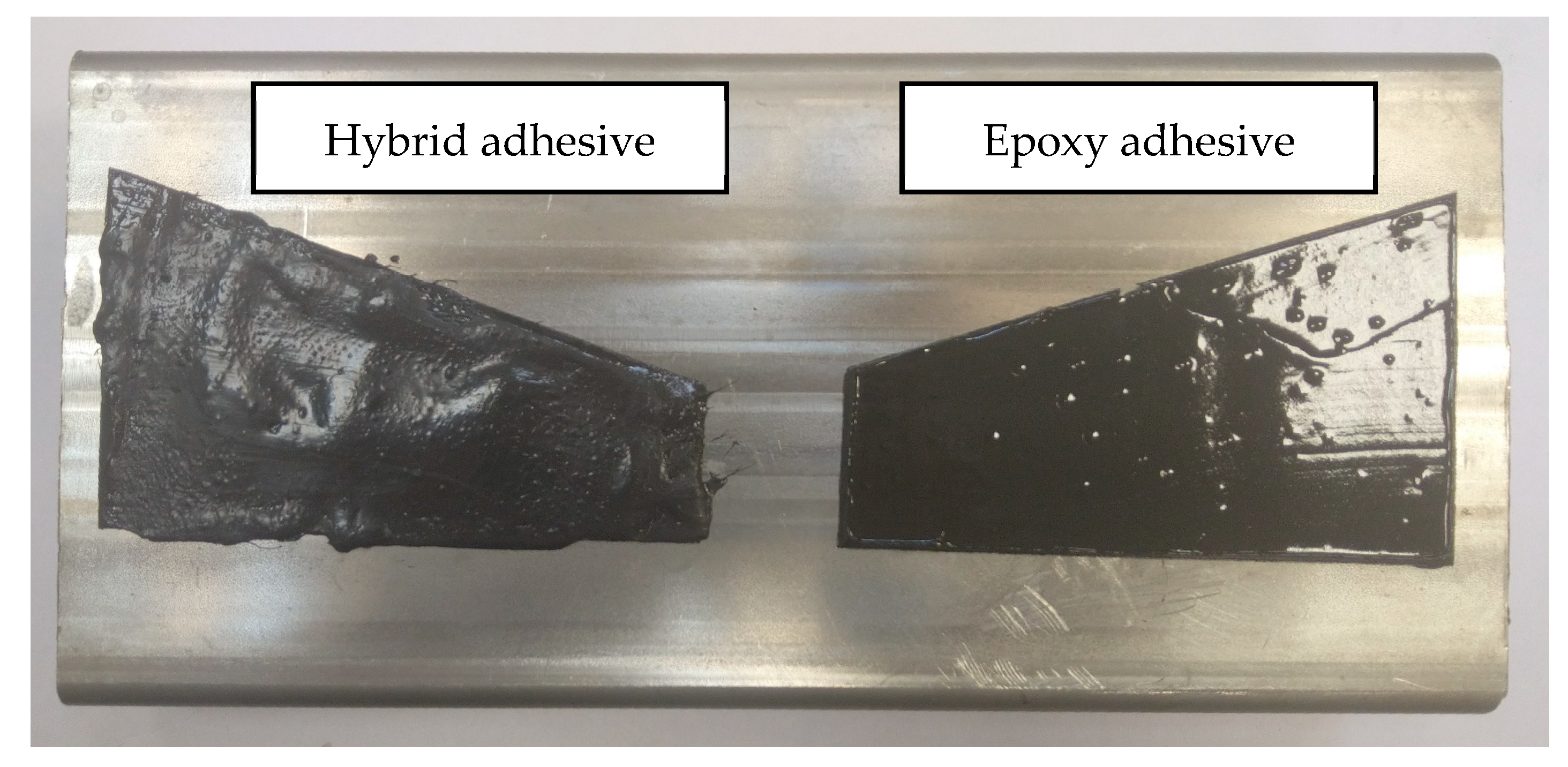

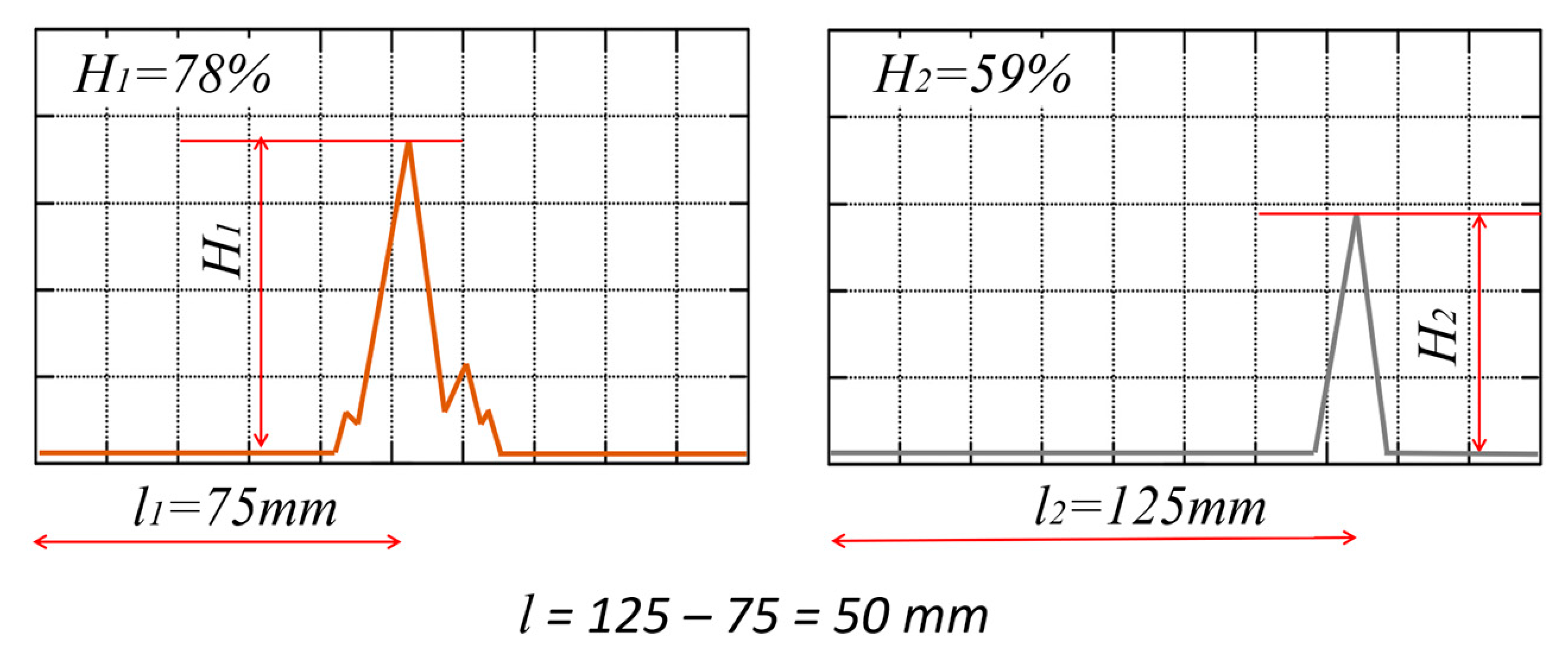
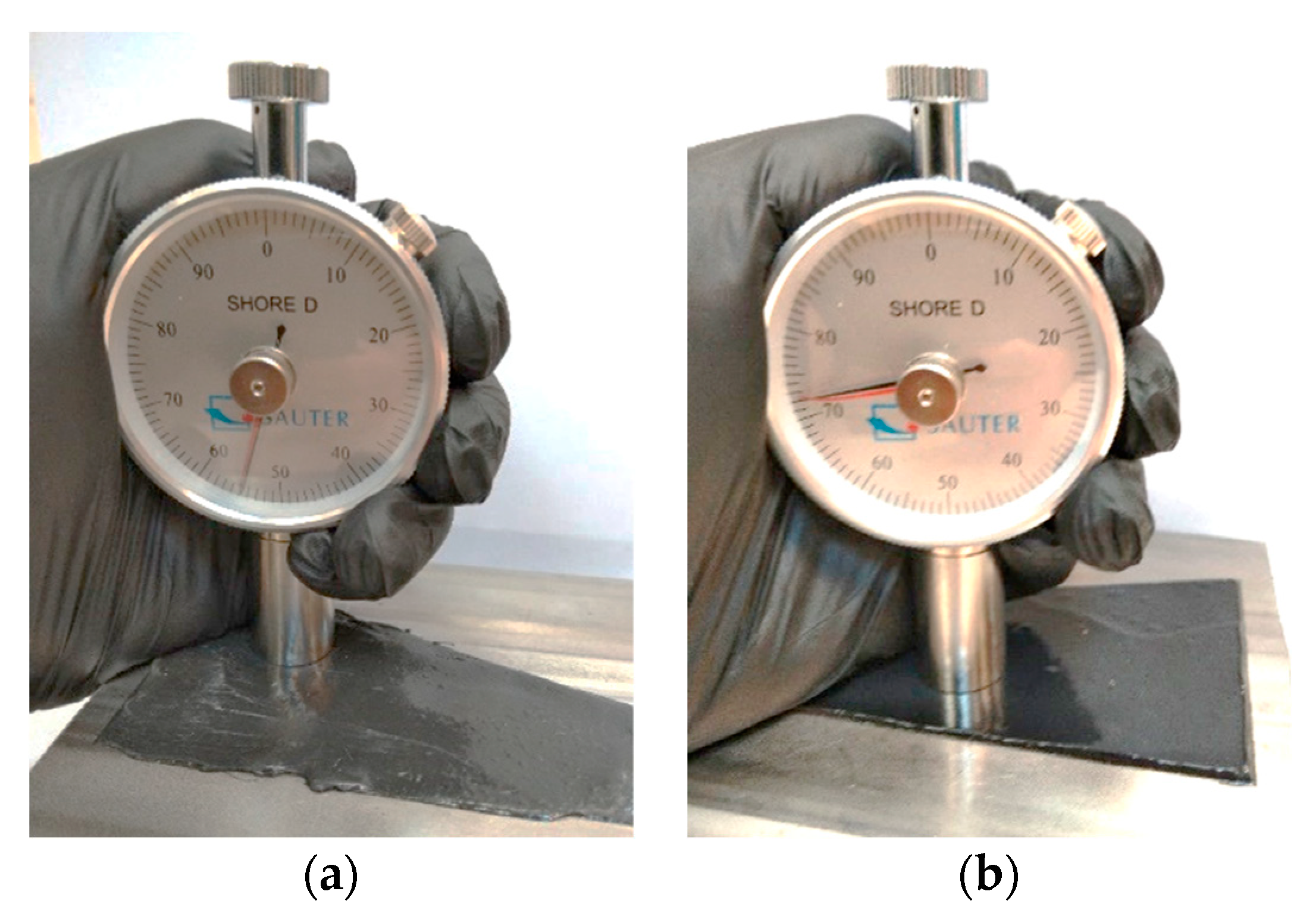
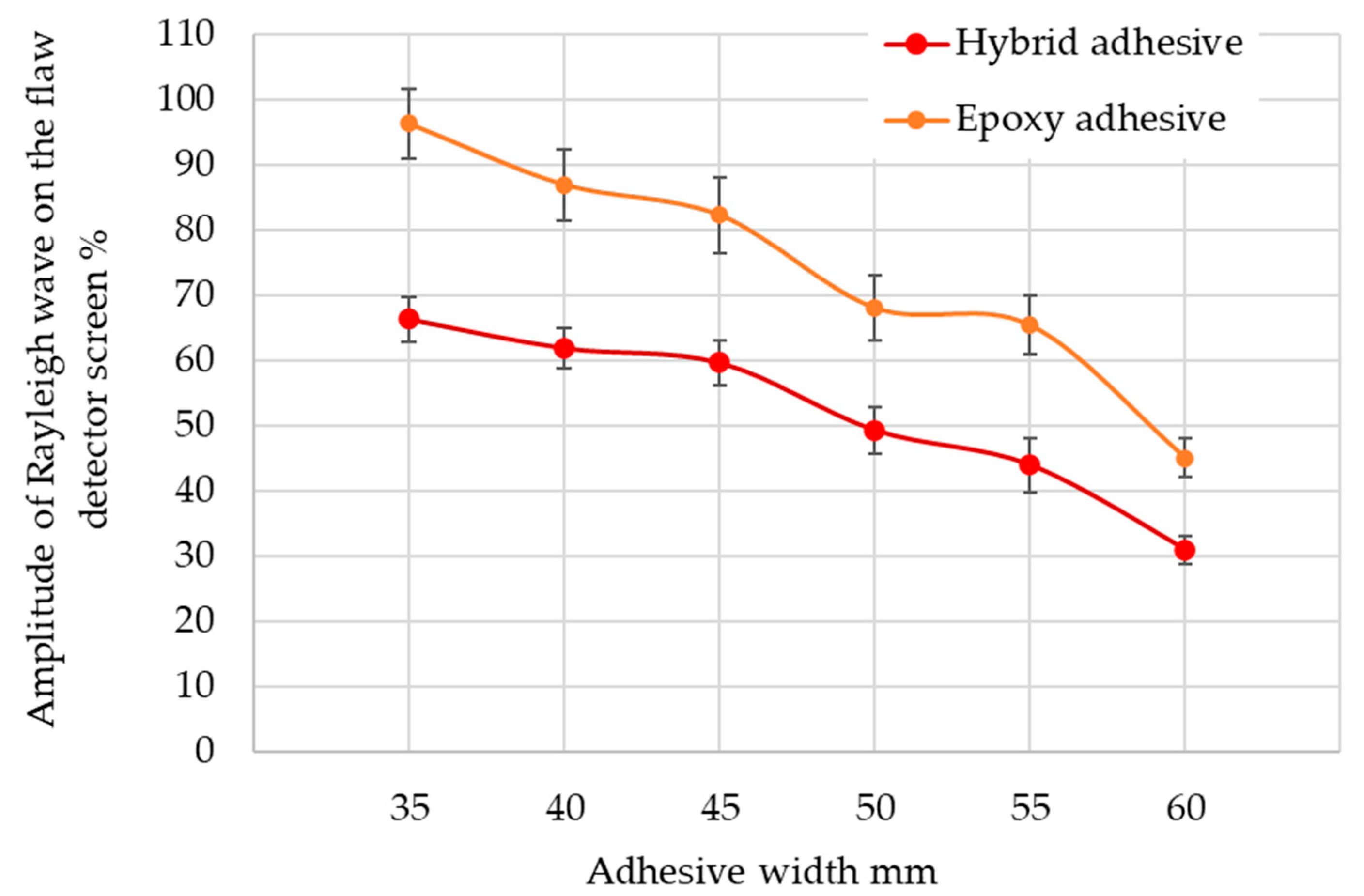


| No | Distance mm | Average Pulse Height% | Standard Deviation | Half Confidence Interval |
|---|---|---|---|---|
| 1 | 75 | 75.567 | 1.116 | 1.896 |
| 2 | 125 | 65.233 | 1.542 | 2.620 |
| 3 | 175 | 56.667 | 1.619 | 2.751 |
| No | H [%] | No | H [%] | No | H [%] | No | H [%] | No | H [%] |
|---|---|---|---|---|---|---|---|---|---|
| 1 | 51 | 11 | 51 | 21 | 54 | 31 | 56 | 41 | 52 |
| 2 | 51 | 12 | 50 | 22 | 53 | 32 | 55 | 42 | 51 |
| 3 | 49 | 13 | 52 | 23 | 55 | 33 | 53 | 43 | 53 |
| 4 | 52 | 14 | 51 | 24 | 56 | 34 | 53 | 44 | 53 |
| 5 | 52 | 15 | 52 | 25 | 52 | 35 | 53 | 45 | 51 |
| 6 | 50 | 16 | 54 | 26 | 53 | 36 | 55 | 46 | 53 |
| 7 | 51 | 17 | 52 | 27 | 53 | 37 | 51 | 47 | 55 |
| 8 | 51 | 18 | 54 | 28 | 53 | 38 | 55 | 48 | 51 |
| 9 | 53 | 19 | 51 | 29 | 53 | 39 | 54 | 49 | 55 |
| 10 | 51 | 20 | 53 | 30 | 54 | 40 | 52 | 50 | 50 |
| Medium Shore Hardness on the D Scale | Standard Deviation | Half Confidence Interval | |
|---|---|---|---|
| Hybrid adhesive | 55.4 | 1.066 | 2.411 |
| Epoxy adhesive | 72.8 | 0.916 | 2.073 |
Disclaimer/Publisher’s Note: The statements, opinions and data contained in all publications are solely those of the individual author(s) and contributor(s) and not of MDPI and/or the editor(s). MDPI and/or the editor(s) disclaim responsibility for any injury to people or property resulting from any ideas, methods, instructions or products referred to in the content. |
© 2024 by the authors. Licensee MDPI, Basel, Switzerland. This article is an open access article distributed under the terms and conditions of the Creative Commons Attribution (CC BY) license (https://creativecommons.org/licenses/by/4.0/).
Share and Cite
Kowalczyk, J.; Ulbrich, D. Evaluation of Adhesive Joints Using Ultrasonic Rayleigh Waves. Materials 2024, 17, 1367. https://doi.org/10.3390/ma17061367
Kowalczyk J, Ulbrich D. Evaluation of Adhesive Joints Using Ultrasonic Rayleigh Waves. Materials. 2024; 17(6):1367. https://doi.org/10.3390/ma17061367
Chicago/Turabian StyleKowalczyk, Jakub, and Dariusz Ulbrich. 2024. "Evaluation of Adhesive Joints Using Ultrasonic Rayleigh Waves" Materials 17, no. 6: 1367. https://doi.org/10.3390/ma17061367





